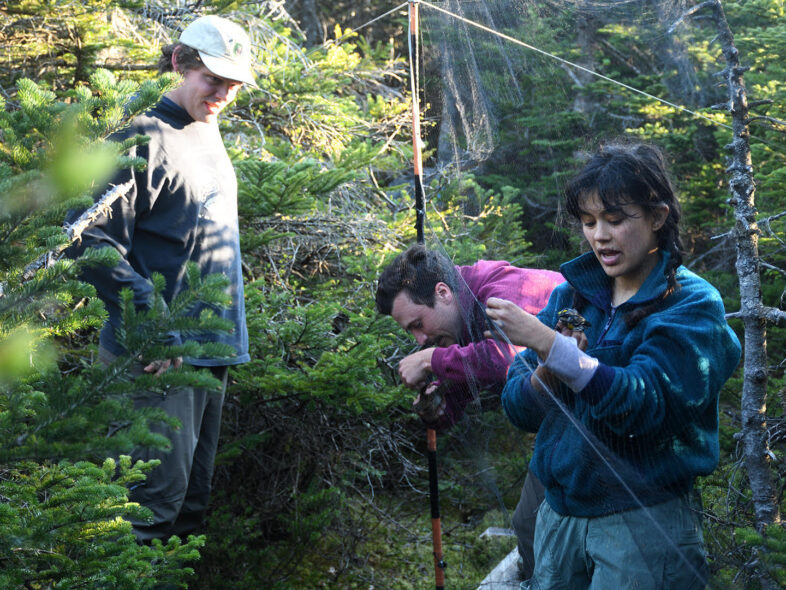
An early net run on Mansfield’s Amherst Trail, 1 June 2023. From left: Kevin Tolan, Nathaniel Sharp, Melory Brandao. © Michael Sargent
One could argue that after 31 years of studying Mt. Mansfield’s ridgeline breeding birds, the time has come to move on and seek new horizons. Well, sorry, that’s just not the VCE way. Our resolute commitment to long-term monitoring of vulnerable wildlife, the inevitability of intriguing new research questions, and the killer views from our Mansfield “office” keep VCE coming back. We launched season #32 on May 31, taking advantage of unseasonably summerlike weather. Four VCE BITHnologists—Kevin Tolan, Nathaniel Sharp, Desiree Narango, and I—arrived in early evening with field technician Melory Brandao, longtime ace volunteer photographer Chuck Gangas, and Vermont Public cinematographer Mike Dunn. Winds were calm, the air hazy, sun still strong, and black flies out in force when we set forth at 5 pm, armed with mist nets and poles, most of us clad in shorts and t-shirts—rare field attire even during the peak of summer on Vermont’s highest peak.
Ninety minutes later we had 25 nets in place at their usual sites on the Amherst, Lakeview, and Long trails. The ridgeline was quiet, the evening serene. A few Bicknell’s Thrush (BITH) and White-throated Sparrows sporadically called and sang. All of us eagerly anticipated the return of backpack-toting BITH, as we had affixed GPS tags to 20 adult birds last summer. Eleven of those (8 males, 3 females) had furnished their tags from the summer of 2021, providing a rich trove of data on migratory movements and whereabouts. Retrieving tags from even a few of these individuals would yield unprecedented insights over two consecutive non-breeding seasons—the soul-stirring stuff of ornithological dreams!
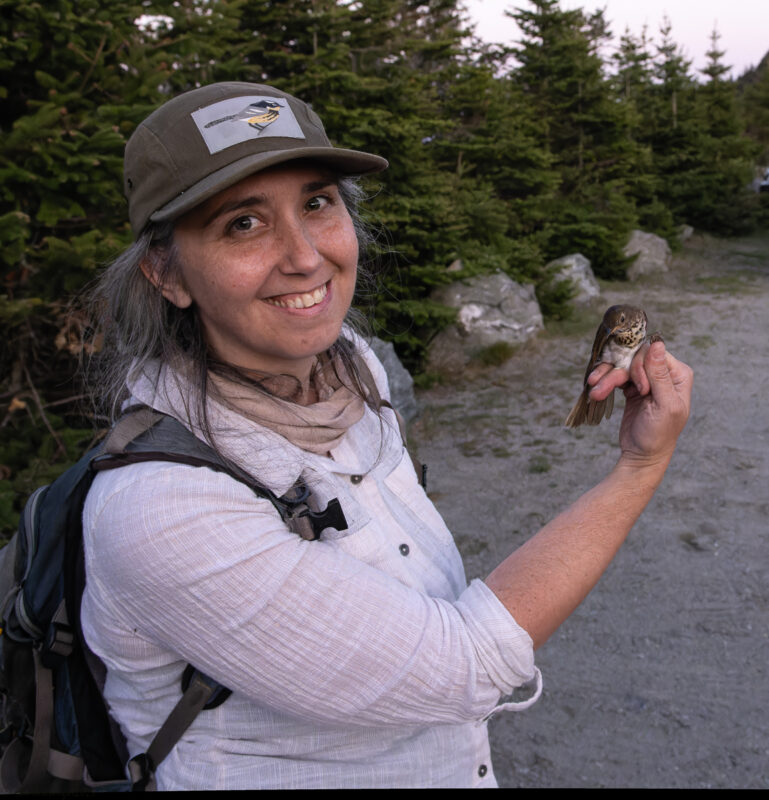
Desiree Narango with VCE’s first mist-netted BITH of 2023, an unbanded yearling male. © Charles Gangas
The first BITH capture at 8:15 pm was an unbanded yearling male—nice but not quite fulfilling lofty expectations. With the dusk chorus imminent, we resorted to trickery, setting a vocal playback at our “Nose Gap” net. The ruse worked, and moments later, two banded BITH nestled in the lower trammels, an antenna clearly protruding from the back feathers of one. Mike Dunn was especially elated, as he needed images of a GPS tag recovery to complete a Vermont Public piece he and Abagael Giles had begun last July. As Mike filmed, Kevin gingerly removed GPS tag #50479 from male BITH 2821-79190 (banded in June 2021 and fitted then with tag #50468). Our season was off to a fine start, and we ended the evening with 25 captures total, including 7 BITH. And, the dusk chorus didn’t disappoint, with BITH courtship flight songs continuing well after dark.
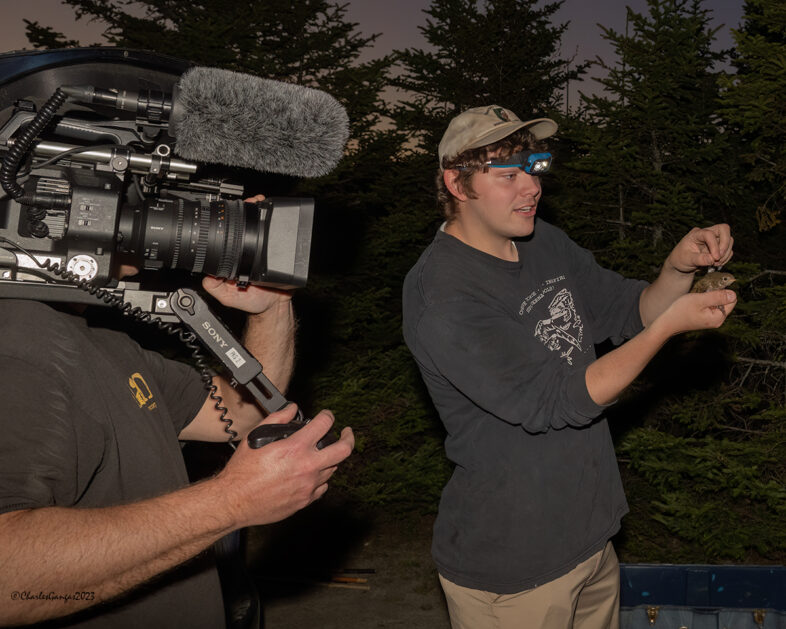
Kevin Tolan carefully removes a precious GPS tag from BITH #2821-79190, as Vermont Public’s Mike Dunn films the encounter. © Charles Gangas
After a relatively balmy night out under the stars, we had nets open by 4:30 and experienced a steady flow of captures through mid-morning, when bright sun and attendant heat quieted activity. In addition to another 7 BITH (including two more with GPS tags, see below), our nets produced inevitable surprises, the highlight being a female Bay-breasted Warbler, which must have been a tardy migrant. A male and female Magnolia Warbler provoked oohs and aahs. Our combined tally of 58 captures included:
Yellow-bellied Flycatcher — 2 of unknown sex
Red-eyed Vireo — 1 of unknown sex
Bicknell’s Thrush — 14 (12 males, 2 probable females); 4 new bandings, 10 returns all banded as SYs in previous years (1 from 2018, 3 from 2021, 6 from 2022)
Swainson’s Thrush — 4 new males
Purple Finch — 1 return male banded in 2022
Dark-eyed Junco (Slate-colored) — 5 (3 new, 1 return from 2021, 1 recapture from previous day)
White-throated Sparrow — 6 (3 new, 1 return each from 2020-2022)
Magnolia Warbler — 2 new bandings, male and female
Bay-breasted Warbler — 1 new female
Blackburnian Warbler — 1 new female
Blackpoll Warbler — 7 (5 new bandings, return male from 2020 and female from 2021)
Yellow-rumped Warbler (Myrtle) — 14 (7 new, 6 returns [3 from 2021, 3 from 2022], 1 recapture from previous day)
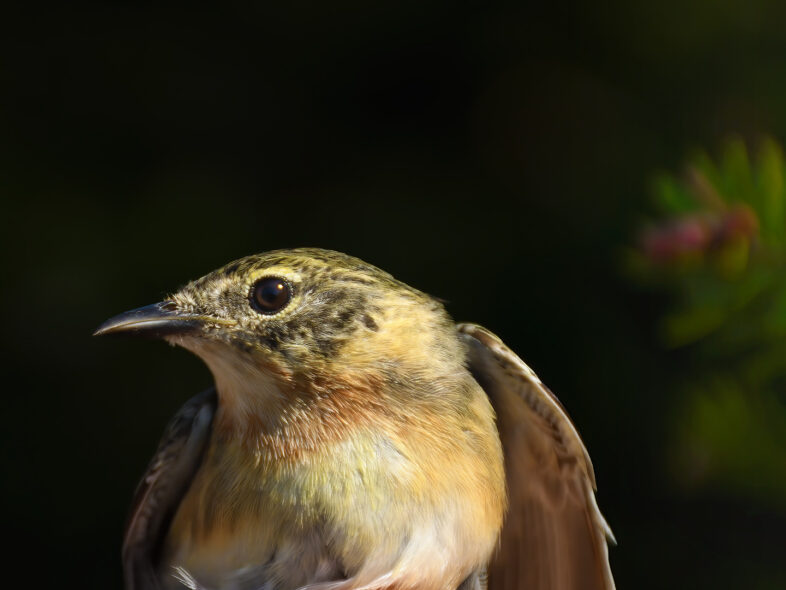
Left: a female Bay-breasted Warbler. This species is very rarely captured on Mansfield before late summer or early fall. © Michael Sargent
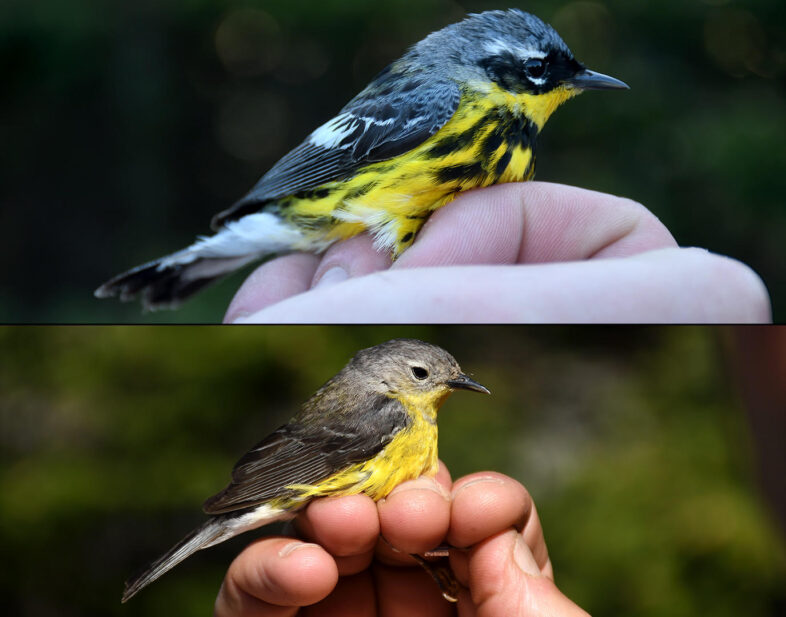
A male and female Magnolia Warbler. This species appears to be gradually moving upslope on Mansfield and is now more common on the ridgeline than 10-15 years ago. © Michael Sargent
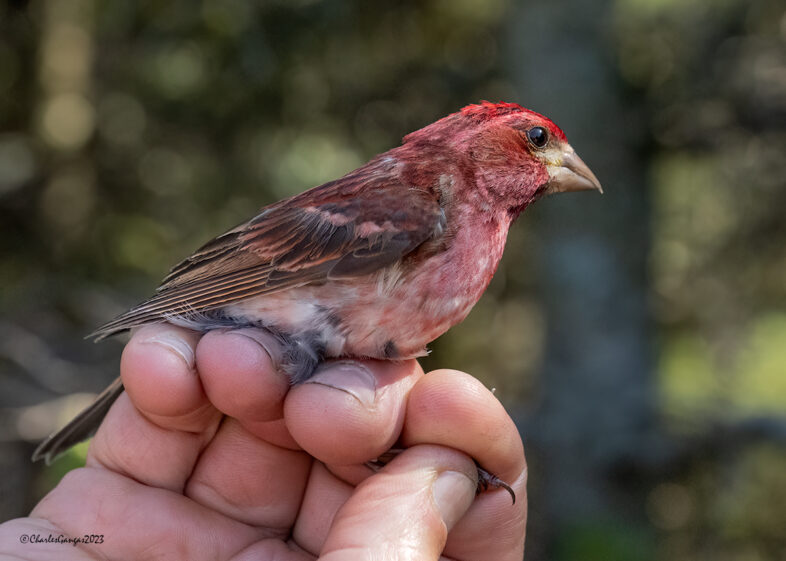
A male Purple Finch banded in 2022; this nomadic species is not often recaptured in successive years on Mansfield. © Charles Gangas
Now, back to those endurance champions, the backpack-lugging BITH. Our exhilaration at recovering GPS tags from three males, two of whom had completed two consecutive annual cycles with their devices, was tempered when we plugged the units into Kevin’s laptop to download their data. Each tag had been deployed in 2021 (one in Quebec, two on Mansfield), fully recharged after recovery in 2022, and then affixed on BITH for a second round. While we had been warned that recharged tags are unlikely to enjoy as long a battery life as brand new units, we were chagrined at our results. The Quebec tag contained no retrievable information at all, while our two from Mansfield had both lost their charge far earlier than expected, one on November 1, the second on November 15. That discovery jolted us, but all is not lost. We’ll send the Quebec unit to its manufacturer Lotek, in hopes that they can recover its data. And, we did gain some useful data from the two battery-shortened tags. One bird was over open ocean just south of eastern Cuba (undoubtedly heading to Hispaniola) when its tag gave out on November 1. The other, male #2821-79231, reoccupied the exact same overwinter site in the DR’s Sierra de Neiba that he used in 2021-22. While we’ll never know about his movements after November 15, this is invaluable information, confirming that at least some BITH are extremely site faithful between winters.
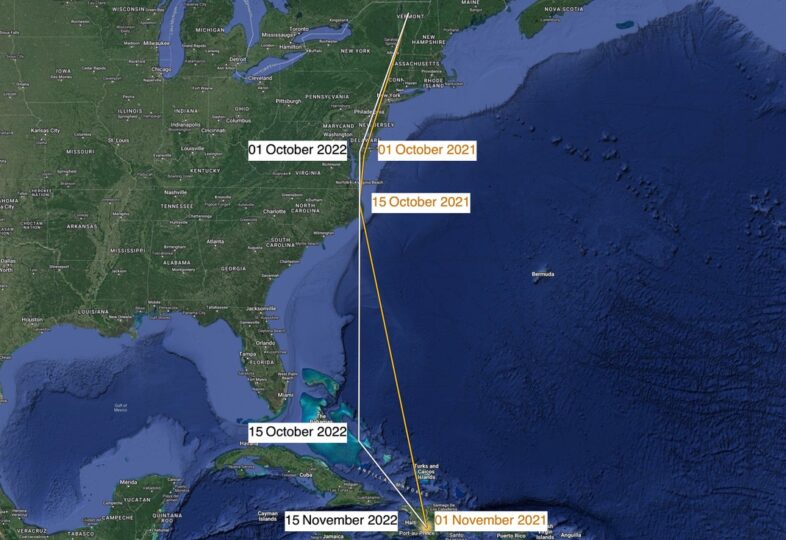
Consecutive years’ GPS tracks (fall 2021 and 2022) of Bicknell’s Thrush 2821-79231, showing nearly identical autumn migration paths in both years, and presumed overwintering sites in the Dominican Republic’s Sierra de Neiba.
Needless to say, we harbor high hopes that we will recover additional GPS tags in the weeks ahead, and that they’ll show more prolonged battery lives than our first two. Regardless, we’ve gained tremendous insights into the year-round movements and spatial patterns of BITH, and we are gaining an increasingly complete picture of this rare, enigmatic species’ full life cycle.
Further, let’s face it: who can complain about a field “office” with a view like ours?? Stay tuned for more updates from our weekly visits.
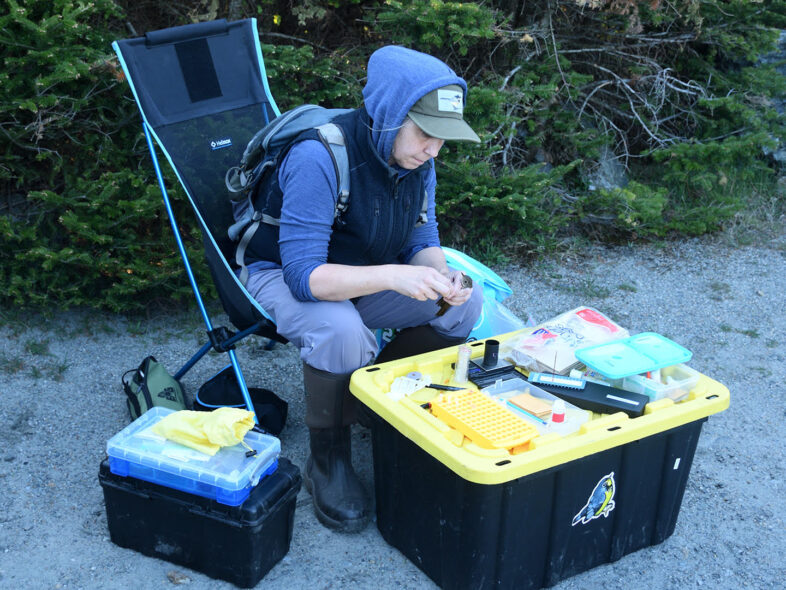
Desiree Narango in her mobile montane forest “lab” for collecting blood and fecal samples (more on this work soon). © Michael Sargent

You reports make for lively reading, informative, entertaining, and well written. Thank you for both the work your doing and the stylish missives.
Opps, you’re doing. Duhhhh.
I always look forward to your reports from on high!
Really enjoy learning how the Bicks migrate plus the other species seen.
Thanks for your hard work!
Hurray – you’re back at it! Looking forward to the seasonal activity and reports.